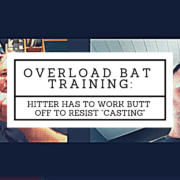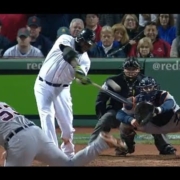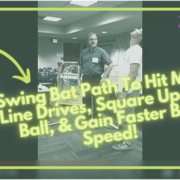Juan Soto Swing Breakdown: Online Directional Place Hitting Power Tips How To Hit A Baseball Or Softball Farther And Harder Every Time
Discover in this Juan Soto swing breakdown: online directional place hitting power tips on how to hit a baseball or softball farther and harder almost every time…
Juan Soto Swing Analysis
In this Juan Soto swing analysis, we’ll discuss:
- Juan Soto swing analysis quick stats,
- Lower half sets directional force,
- Hitting it back through tube, and
- Catapult Loading System…
As Matt Nokes has said, it takes 8,000-pounds per square inch of force, in one direction, to hit a ball 400-feet. The swing is both linear and rotational. Not either or. When I say lower half sets the directional force, it’s just that. Lower half should rotate the list of all major segments. Why?
SCIENCE-BASED TRAINING:
Improve your hitting strategy dramatically by applying human movement principles.
Learn not only how and what to train but also the science behind the methods.
Every human movement revolves around three parts to the spine. The lower half coordinates with the lower back. The vertebrae in the Lumbar, which by the way isn’t made the rotate. The Lumbar is only made to flex and extend. The rotation we see is because of the muscles and ligaments surrounding the vertebrae in the Lumbar. Between 7-12 degrees of rotation are allowed.
The ability to rotate is much different when talking about the middle portion of the spine, the Thoracic. The 12 vertebra in the Thoracic IS made the rotate, flex, and extend. It is allowed 40-degrees of rotation in each direction. What’s my point?
Let the section of the spine fulfill their natural roles. Lumbar and lower half of the body rotates the least, and sets directional force. Middle part of the spine rotates the most, and will optimize whip. And when talking Catapult Loading System principles … we’re talking about what the middle is doing…
- Best Hitting Drills for 8-Year-Olds (2025): Fix Swing Flaws Fast with This MLB-Trusted Youth Baseball System—At-Home, Step-by-Step, and Built for Game-Day Confidence - July 5, 2025
- Best Youth Baseball Hitting Program to Boost Rotational Power Fast—Trusted by MLB’s Rajai Davis & Built on the Catapult Loading System - June 22, 2025
- The #1 Arm Care Program for Youth Baseball: Why Top Travel Coaches Trust Jaeger’s J-Bands & Long Toss Routine to Prevent Injury Fast - June 3, 2025













Joey,
Soto is a great talent and only 21! Great job but you got more work to do. Do Soto’s bomb into the upper deck off of Verlander in Game 6.
Btw, if Pedro Martinez was pitching, Soto’s belt may have been in the direction of the 3B dugout because his butt would have on the ground because of his “let them play” antics.
I know…Soto’s personality reminds me of a younger Puig. I hope he proves me wrong.
Joey,
Somebody got to him because he cut out a lot of the nonsense he did against the Cardinals. He doesn’t have to do it. He’s got God-given talent.
Agreed
Joey,
One thing you didn’t cover is the fact that Soto doesn’t “skip his back foot,”. Though he gets very wide after his stride or his two strike no-stride approach. He loses some forward momentum but you wouldn’t know it by the distance of the home runs he hit.
Exactly. From my experience working with hitters and swing experiments, stride length does not give much to batted ball distance. It’s the spinal engine.
Joey,
Yes, I realize that. So, the distance the back leg travels with a back foot skip seen with guys like Mickey Mantle and Javier Baez, adds no force into contact?
Joe, the lengthy stride v. wide no-stride swing experiment I did only showed a 0.5-mph avg. increase in bat speed: https://gohpl.com/2o4DgVN I’m not saying the legs and momentum don’t contribute to power, it’s just that they don’t contribute as much as people think.
Joey,
I can’t argue with your findings. What was the BES in that study? Not a fan of the no-stride approach except with two strikes. Albert Pujols went back to striding for a reason. Just a theory but I think that David Wright’s neck and back problems could be attributed to his no-stride approach. Forward momentum accounts for something, I’d say.
Yeah, not sure neck and back problems can be connected to wide no-stride, but I do know stride type isn’t a big power upgrade – if adding much at all. Stride type is all about timing.
Joey,
Yes, I understand and do not dispute. I still feel that the momentum of the stride contributes something, which I think is lacking in the no-stride swing. Also, got a feeling that a leg lift/kick creates more GRF by allowing gravity to work longer on that front leg. Why else would hitters like Josh Donaldson and Justin Turner convert to doing it? No, I am not a heretic and realize the critical role of the spinal engine and the example of the water polo player that you refer to in one of your articles. I think that example of the water polo player is indisputable.
Totally. Joe I’m not saying the legs or forward momentum don’t benefit the swing at all. They do. But we have to understand what the benefits are and aren’t.
Joey,
Smaller guys like Donaldson and Turner getting something positive out of those leg lifts. Didn’t hit like they have subsequent to adopting those leg lifts with their former approaches. Also, their coil gives them more time to see the pitch.
I agree Joe, sometimes hitters have to try something different in their strides…it’s basic split A/B testing…experiment with a leg kick, slide step, toe-tap, or hip slide (wide no-stride)…and see which one gets you on time more often. And pick the winner. And if later, hitter feels it’s not working, then go back to experimenting again.
Joey,
Yep, Pujols has gone back and forth and back again. I think he is doing a leg lift and stride now. Timing is the key. Remember B. J. Upton’s no-stride/toe tap thing? Hardly ever on time.
Wide no stride is definitely a challenge to get on-time. It does have it’s use, maybe against above avg. velo and/or with 2-strikes.
Joey,
I agree. I saw people at facilities teach the no-stride when it first came out around early 2000s. Not pretty – they taught kids literally not to stride! No linear movement or weight shift at all – with no counter-rotation, the front foot just stayed there with no heel plant. The player involved couldn’t hit the ball past 2B! Yet, both the kid and his father bought into it because the guy who owned the facility played in the Dodgers system. Can’t make this stuff up.
Like a cartoon!
Joey,
More fraud than a funny cartoon. Really not funny at all when you see the effects of some selling people stuff like that and you’re stuck with telling them they have been taken.
Believe me when I say I know what you mean. Have had to do it plenty of times. I’ve learned to do it in a nice way though, so as not to bash other instructors.
High school coaches are held hostage. In order to free oneself, “the gloves come off.” Pleasantries are eschewed for whatever phraseaolgy gets the job done.
Totally agree.
Joey,
There is no excuse for money grubbing bs-ing frauds, who pass themselves off as hitting instructors. Nor are there excuses for gullible, pliable people who fall for their bs.
You’re preaching to the choir my friend!
Joey,
Yes, I know but the situation is not good. I’ve seen it all too often. These so-called instructors play parents against the coaches, often who are political appointees (but, what if they are not), by throwing their professional baseball experience at them. When people shell out lots of money, who are they to believe? It’s a completely unregulated, buyer beware industry.
I agree. And People like me get the harsh words, thinking we’re in it just for the “money”. Because that’s what they’re experiencing with these coaches and programs you speak of. They really give a bad name to the industry.
Joey,
Well, the money helps but it starts with a passion for hitting and a sense of pride in what you do. I was charging $100/hour – $60 for me and $40 to rent the cage for an hour. When they asked how much I was charging, they thought I was nuts because they were getting $120 an hour for lessons. When i just worked at a town field i would do lessons for an hour and a half for $75.
The worst part is when I work with a player and his high school coach teaches something different. Vice versa is just as frustrating. One coach taught everyone on his team to swing down because they play on an all dirt infield that became pavement if it didn’t rain for awhile.
Joe, you gotta switch to small private group lessons. I can make up to $180/hr. That little extra helps when you have to pay cage rent. I hear ya on team coaches teaching opposite you. Very frustrating indeed.